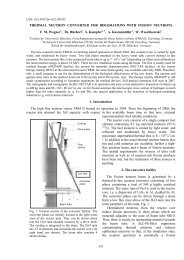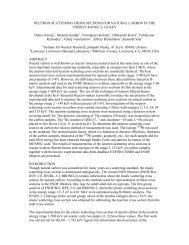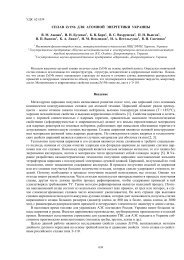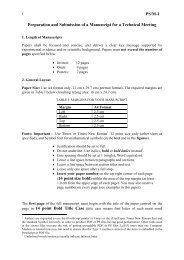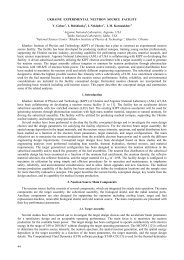Dinh Dang.pdf
Dinh Dang.pdf
Dinh Dang.pdf
You also want an ePaper? Increase the reach of your titles
YUMPU automatically turns print PDFs into web optimized ePapers that Google loves.
Within assumptions (a1) and (a2) the model has only three T -independent parameters, which are the<br />
unperturbed phonon energy ω q<br />
, F<br />
1, and F 2<br />
. The parameters ω q<br />
and F 1<br />
are chosen so that after the<br />
ph -GDR coupling is switched on, the calculated GDR energy E GDR<br />
and width Γ GDR<br />
reproduce the<br />
corresponding experimental values for GDR on the ground-state. At T ≠ 0, the coupling to pp and hh<br />
configurations is activated. The F<br />
2<br />
parameter is then fixed at T = 0 so that the GDR energy E<br />
GDR<br />
does not<br />
change appreciably with T .<br />
B. Temperature dependence of GDR width<br />
Shown in Fig. 1, a is the T dependence of the neutron pairing gap ∆ ν for 120 Sn, which is obtained from<br />
the MBCS equation (15) using the single-particle energies determined within the Woods - Saxon potential at<br />
T = 0. The pairing parameter G ν<br />
is chosen to be equal to 0.13 MeV, which yields<br />
∆ ( T = 0) ≡∆(0)<br />
1.4 MeV. Contrary to the BCS gap (dotted line), which collapses at T c<br />
0.79 MeV, the<br />
gap ∆ (solid line) does not vanish, but decreases monotonously with increasing T at T 1 MeV resulting in<br />
a long tail up to T 5 MeV. This behavior is caused by the thermal fluctuation of quasiparticle number in<br />
the MBCS equations (15) and (16).<br />
Fig. 1. Neutron pairing gap for 120 Sn as a function of T . Solid and dotted lines show the MBCS and BCS gaps,<br />
respectively (a). GDR width Γ<br />
GDR<br />
as a function of T for 120 Sn (b). The thin and thick solid lines show the<br />
PDM results obtained neglecting pairing and including the renormalized gap 2<br />
∆ = [1 + 1 / δ N ] ∆, respectively.<br />
The gap ∆ 2 2 2 2<br />
includes the correction δN<br />
=∆ (0) ∑ ( j+ 1/ 2) /[( ε<br />
j<br />
− ε F) +∆(0) ] due to an approximate<br />
j<br />
number projection. The prediction by the TFM is shown as the dotted line [11].<br />
The GDR widths as a function of T for 120 Sn obtained within the PDM are compared in Fig. 1, b with the<br />
experimental data and the prediction by the thermal fluctuation model (TFM) [11]. The TFM interprets the<br />
broadening of the GDR’s width via an adiabatic coupling of GDR to quadrupole deformations induced by<br />
thermal fluctuations. Even when thermal pairing is neglected the PDM prediction, (the thin solid line) is<br />
already better than that given by the TFM, including the region of high T where the width’s saturation is<br />
reported. The increase of the total width with T is driven by the increase of the thermal width Γ<br />
T<br />
(8c),<br />
which is caused by coupling to pp and hh configurations, since the quantal width Γ<br />
Q<br />
(8b) is found to<br />
decrease slightly with increasing T . The inclusion of thermal pairing, which yields a sharper Fermi surface,<br />
compensates the smoothing of the Fermi surface with increasing T . This leads to a much weaker<br />
T -dependence of the GDR’s width at low T . As a result, the values of the width predicted by the PDM in<br />
this region significantly drop (the thick solid line), recovering the data point at T = 1 MeV.<br />
The results discussed above have also been confirmed by our recent calculations within a macroscopic<br />
approach, which takes pairing fluctuations into account along with the thermal shape fluctuations [12]. Here the<br />
free energies are calculated using the Nilsson - Strutinsky method at T ≠ 0, including thermal pairing correlations.<br />
The GDR is coupled to the nuclear shapes through a simple anisotropic harmonic oscillator model with a separable<br />
dipole-dipole interaction. The observables are averaged over the shape parameters and pairing gap. Our study<br />
reveals that the observed quenching of GDR width at low T in 120 Sn and 148 Au can be understood in terms of<br />
simple shape effects caused by pairing correlations. Fluctuations in pairing field lead to a slowly vanishing pairing<br />
gap (Fig. 2, a), which influences the structural properties even at moderate T (∼ 1 MeV). We found that the<br />
lowT -structure and hence the GDR width are quite sensitive to the change of the pairing field (Fig. 2, b).<br />
75





